Doesn't this look a little lengthy and somewhat confusing? However, do you see what each term has in common? Let me give you a hint: each term is divisible by 3, x and y. Taking these out of this expression, we will get a shorter and more straightforward expression. Though, more on that later!
In this article, we will be exploring factoring polynomials, their definition, how to solve polynomial equations and examples of applications of this.
Factoring
We will now begin with the definition of factoring.
Factoring is a process in which we write a number or an expression as a product of its factors.
This is an important topic when dealing with complex polynomials. Let us take the following example:
Factor the value of 20.
Solution
There are many ways to break down the product of 20.
Take 2 x 10 = 20, for instance.
However, 10 is not a prime and so we can further break down this product, as below
2 x 2 x 5 = 20.
Now, we can no longer simplify the components that make up this product. Thus, it has been completely factorised.
In algebra, factoring a (higher degree) polynomial means that we are rewriting a polynomial as a product of lower degree polynomials. Essentially, what we are doing here is the opposite of the FOIL method. Given the product of two binomials (a + b)(c + d), recall that the FOIL method is given by
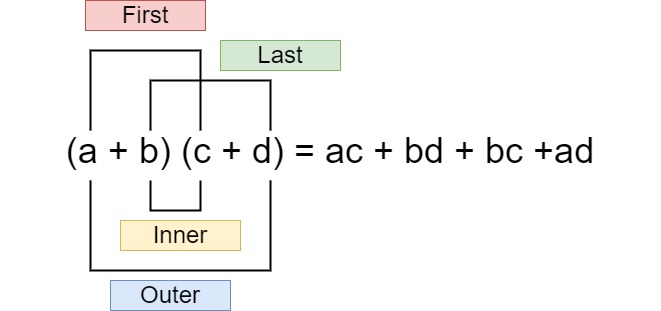
Foil method, Aishah Amri - StudySmarter Originals
FOIL stands for First, Outer, Inner and Last.
This is the result of expanding the product of the two binomials. We aim to simplify a polynomial so that it is displayed as a product of its lowest degree polynomials rather than multiplying it out.
Before we get into this topic, let us recall the following definitions.
A monomial is a polynomial with only one term. For example, 2x.
A binomial is the sum of two monomials. For example, 3x + 1.
A trinomial is the sum of three monomials. For example, x + 2y + 5.
Why is Factoring Important?
In most cases, factoring plays an important role in simplifying an expression. This allows you to solve a particular equation in a more efficient way. Furthermore, factoring will help you understand the behaviour of a polynomial expression when graphing is required. We can also solve equations through factoring polynomials by identifying their solutions. The following are the learning objectives for this section:
- Factoring a polynomial
- Solve polynomial equations via factoring
Here, we shall be introduced to three types of factoring methods, namely:
Greatest common factor (GCF)
Quadratic trinomials
Grouping
Greatest Common Factor
The Greatest Common Factor (GCF) is the highest common monomial shared between all the components of a polynomial. When factoring polynomials, it is important to start by using this method to avoid dealing with larger numbers.
To perform this method, we first seek the GCF and factor it out of the polynomial. Fundamentally, we are carrying out the reverse of the distributive law, or in notation form:
The general case for factoring polynomials using the GCF is:
Notice that all the terms on the left-hand side of the general form above have the common factor ab. Below are some worked examples to demonstrate this factoring method:
Factor out the GCF from the following expression,
Solution
Here, we can factor out 5 and x2 from every term. In doing so, we obtain
Factor out the GCF from the following expression,
Solution
Notice that each term contains both x3and y. Thus, factoring these out yields
Factor out the GCF from the following expression,
Solution
Firstly, observe that each term contains the binomial (2x + 7). Factoring this out yields
Now notice that we can further take out 3x from (9x2 - 12x). This will give us the final factorized form as
Try verifying the factorized results using the FOIL method. Does it give the same expression?
Quadratic Trinomials
A second-degree polynomial is known as a quadratic. This means that the largest exponent in the polynomial is a 2. Typically, they take on the form of a quadratic trinomial as there are three terms, that is:
For this method of factoring, we seek to factor quadratic trinomials into a product of first-degree binomials. There are five steps to consider when applying this method:
Step 1: Write down a pair of parenthesis: ( ) ( )
Step 2: Deduce the product of the first term in the trinomial and add it into the parenthesis as:
Step 3: Look for factors of the third term of the trinomial. This should be in the form of a pair, such as
Step 4: Use the trial and error method to identify which pair of factors satisfy the quadratic polynomial. In other words, find the pair that add up to the middle term of the trinomial. Remember to plug in all possible pairs and every possible order to determine the correct pair of values.
Step 5: Once found, add these values into the complete factorized form:
This form of factorization can be rather lengthy and complicated. Mastering this technique comes with lots of practice! Once you get the hang of the trial and error method, it will be very straightforward. We shall make use of the general formula below when factoring quadratic trinomials:
Let us now look at some worked examples that exercise this factoring method.
Factorize the quadratic trinomial below,
Solution
Steps 1 and 2: We start by looking at the first term, x2. Factoring this may look like the expression below
since multiplying x by x gives us x2.
Step 3: To determine the values that go into the blank spaces, we must find a pair of numbers that multiply to get –12 and add to get 1. We do this by looking for factors of the last term, –12. Listing this down, we get the following pairs.
(-1)(12), (1)(-12), (-2)(6), (2)(-6), (-3)(4), (3)(-4)
Step 4: We find that the pair (-3)(4) satisfies the polynomial.
Step 5: Writing this in the final factored form, we obtain
Important note: To determine the right pair of components in the factored form, be sure to plug each pair of factors into both possible forms and orders when using the trial and error method.
Factorize the quadratic trinomial below,
Solution
Steps 1 and 2: Looking at the first term, we have two possible factored forms,
Step 3: To find the missing numbers, we observe the factors of the last term, –10.(–1)(10), (1)(–10), (–2)(5), (2)(–5)
Step 4: From here, we need to look for a pair that also adds up to 11 on top of the criteria that its product equates to -10. Step 5: With some trial and error, we obtain the final factorized form as
Factorize the quadratic trinomial below,
Solution
Steps 1 and 2: We can see that the first term takes on the factorized form
Step 3: We must find a pair of numbers that multiply to get –8 and add up to get 2. Looking at the final term, –8, we can list down its factors as
(-1)(8), (1)(-8), (-2)(4), (2)(-4)
Step 4: Plugging these into the blank spaces one by one tells us that (-4)(2) is the correct pair.
Step 5: In doing so, our final factorized form becomes
Grouping
The grouping method is often used when we encounter a polynomial with four terms. There are three steps to this method:
Step 1: Group the polynomial into two sets of two terms. This is usually done by splitting the first two terms and the last two terms of the polynomial as,
Step 2: Factorize each group using the GCF factoring method:
Step 3: If we find a common polynomial between the two factorized groups, apply the GCF factoring method again to factor it out:
The general case for factoring polynomials via grouping is as follows:
We shall now observe the following worked examples that employ this factoring method.
Use the grouping method to factorize the polynomial
Solution
Step 1: We start by grouping the first two terms and last two terms as below.
Step 2: Notice that we can factor out x2 from the first group and –3 from the second group.
Step 3: Now observing that both groups have a common binomial (x + 2), we can factor this out to obtain
Use the grouping method to factorize the polynomial
Solution
Step 1: As before, we start by grouping the first two terms and last two terms as below.
Step 2: Notice that we can factor out 3y from the first group and 5 from the second group.
Step 3: Now observing that both groups have a common binomial (x – 7), we can factor this out to obtain
Use the grouping method to factorize the polynomial
Solution
Step 1: Start by grouping the first two terms and last two terms as below.
Step 2: Notice that we can factor out x from the first group and –2 from the second group.
Step 3: Now observing that both groups have a common binomial (x4 + 1), we can factor this out to obtain
Grouping 3-Term Polynomials
Grouping is an amazing way to factor 3 term polynomials as well! Say we are given the expression below
Here, we shall use the trial and error method to find the 2 numbers that add to b and multiply to get ac. This makes a 4 term polynomial as below.
Finally, we shall apply the grouping method to simplify the expression as before
Let us look at the example below.
Use the grouping method to solve the trinomial,
Solution
Here, a = 1, b = –8 and c = –9. The product of ac is –9. We need a pair of numbers that add up to –8 and yield –9 when multiplied together. Our 4-term polynomial should look like this:
To find the missing numbers, we shall look at the middle term, –8. Notice that if we add 1 to –9 we obtain –8. The product of 1 and –9 is –9, that is ac. We thus have the following 4-term polynomial.
Now, let us group the first two terms and the last two terms as below.
Notice that we can factor out x from the first group and –9 from the second group.
Now observing that both groups have a common binomial (x + 1), we can factor this out to obtain
Factoring Polynomials of Higher Degree
So far, the polynomials that we have dealt with have a degree of two. What if we need to factorize polynomials of degree higher than that?
When tackling such expressions, there is no particular method in factorizing them. However, we can indeed apply the techniques introduced in this lesson. It is helpful to become well acquainted with these factoring methods so that you can easily seek common patterns when solving them. Let us look at some worked examples to show this.
Completely factorize the expression
Solution
First, notice that we can factor out x3 from each term.
Now we have the quadratic trinomial . From the first term the factorized form will take on the structure.
We need to find a pair of numbers that multiply to get –26 and add to get –7. Let us look at the factors of the term –26.
(-1)(26), (1)(-26), (-2)(13), (2)(-13)
Using trial and error, we find that the pair (–13)(2) satisfies the criteria for this factored form, and so the fully factorised form for this polynomial is
Fully factorize the expression
Solution
We begin by using the grouping method to factorize this. Grouping the first two terms and last two terms, we obtain
We can factor out x2 from the first group and –9 from the second group.
We now have the common factor of (x – 2) in both groups. Factoring this out yields,
Now, you may think that we have completed factoring our expression here. However, this is not the case. Observe the binomial . This is an example of a perfect square binomial. We will look at this in more detail on the topic of Special Products.
To avoid confusion, we shall treat this as a quadratic trinomial where the middle term is essentially zero. By the first term, we can see that the factorized form must look like the following
Now we need to look for a pair of numbers that multiply to get –9 and add up to get 0. The pair (–3)(3) is the most possible answer here. Thus, we obtain
Factorize the expression
Solution
First, notice that this expression looks similar to a quadratic trinomial. Let us use grouping to solve this. This 3-term polynomial will take the form of the 4-term polynomial below
We must now find 2 numbers that add up to get –13 and multiply to get 36. By trial and error, we find that the pair –4 and –9 satisfy this criterion.
Grouping the first two terms and last two terms, we obtain
Factoring x2 from the first group and –9 from the second group, we get
Notice that we can factor out (x2 - 4) from both groups, yielding
But we are not done yet! Just like the previous examples, we have the perfect square binomials . Thus, we can further factorize this. Using the same principle as before, we finally obtain
Solving Polynomial Equations
Now that we have mastered factoring polynomials, we can move on to solving them! Say we have the standard form of a polynomial equated to zero as below:
As before, we know that the factorized form for this polynomial is:
Notice that the product of these two factors is zero if at least one of the factors is zero, that is either . This is known as the Zero Product Property, stated below:
The Zero Product Property
If ab = 0 then a = 0 or b = 0 (or both a = 0, b = 0)
Applying this property, we can solve the general form of a factorized polynomial as above, by identifying that:
Rearranging this in terms of x, we have two solutions:
Do you see how factoring plays an important role in solving equations? Solving the equation via factoring provides the x-intercepts of the graph for a given equation. Let us return to the last three worked examples we did to show this.
Find the solutions to the polynomial below using the Zero Product Property
Solution
From our solution above, the factorized form is
As we have a product of 3 factors, we must have 3 solutions. Applying the Zero Product Property, we obtain
Solving these for x, we obtain 3 real roots
Find the solutions to the polynomial below using the Zero Product Property
Solution
The factorized form is
As we have a product of 3 factors, we must have 3 solutions. Applying the Zero Product Property, we obtain
Solving these for x, we obtain 3 real roots
The graph is shown below.
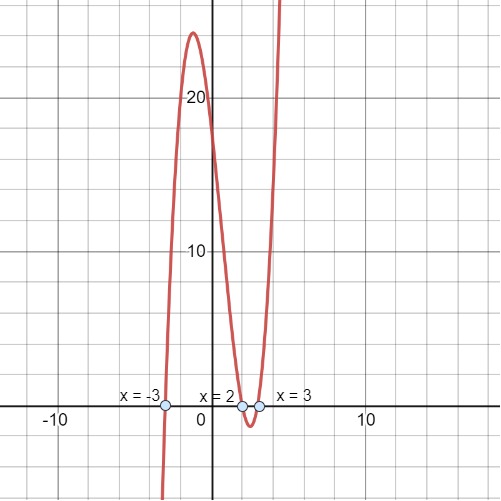
Example 1, Aishah Amri - StudySmarter Originals
Find the solutions to the polynomial below using the Zero Product Property
Solution
We have the factorized form as
As we have a product of 4 factors, we must have 4 solutions. Applying the Zero Product Property, we obtain
Solving these for x, we obtain 4 real roots
The graph is shown below.
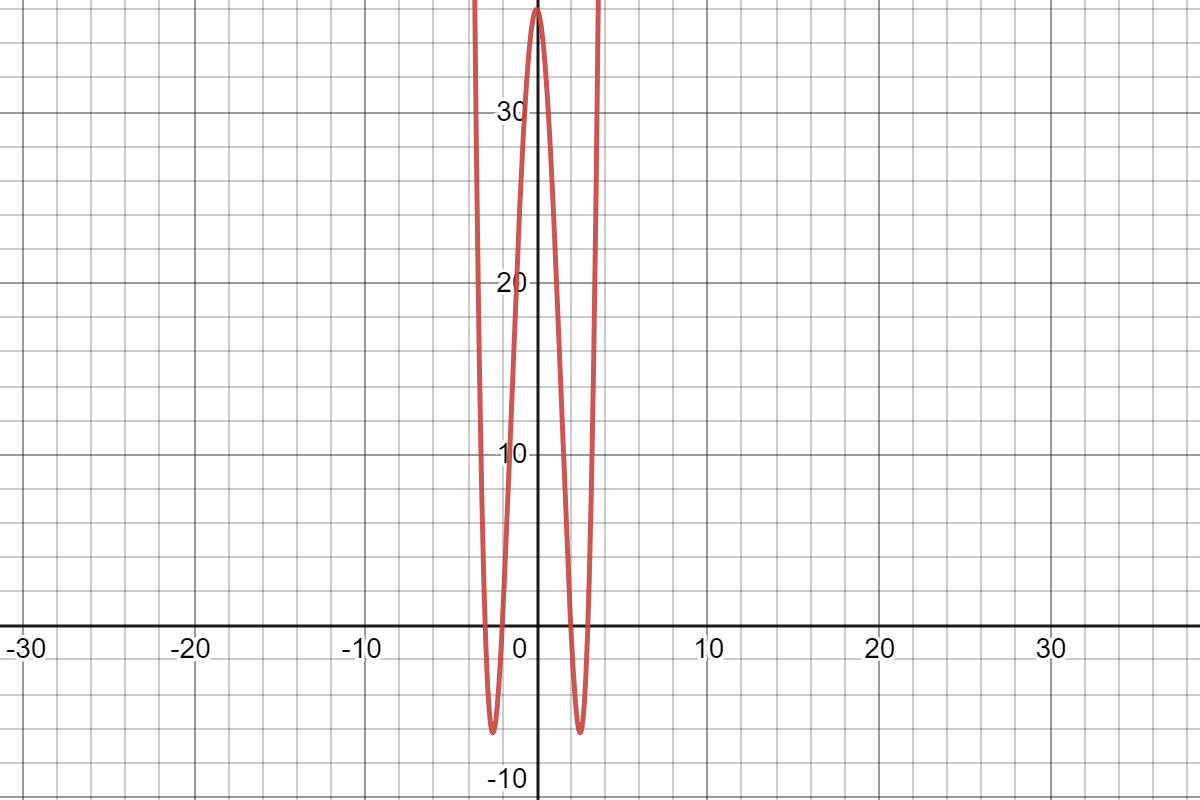
Example 2(1), Aishah Amri - StudySmarter Originals
Zooming into the x-intercepts, we have
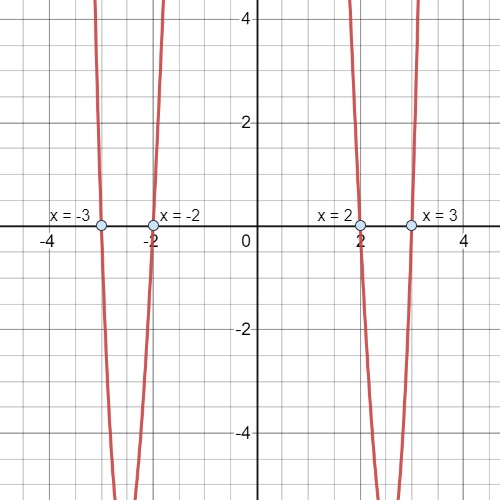
Example 2(2), Aishah Amri - StudySmarter Originals
It is helpful to note that when solving repeated factor equations, we only obtain one solution. For example,
Solve
Solution
Square root both sides.
The square root of zero is zero. Solving this yields
Thus, we only have one real solution, as stated. The graph is shown below.
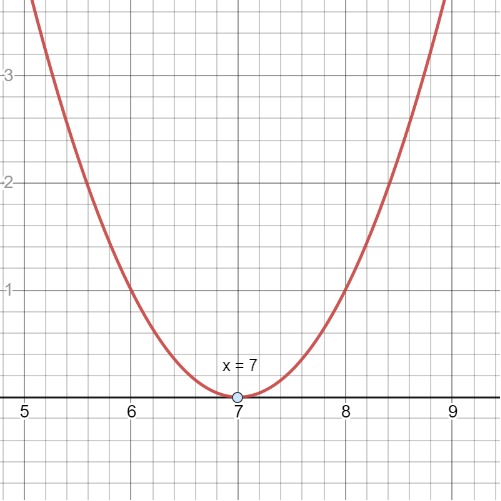
Example 3, Aishah Amri - StudySmarter Originals
Factoring Polynomials - Key takeaways
- Factoring a polynomial means is a process of rewriting a polynomial as a product of lower degree polynomials.
- Factoring plays an important role in simplifying an expression.
- The Zero Product Property states that if ab = 0 then a = 0 or b = 0 (or both a = 0, b = 0).
- Use the Zero Product Property to solve a factored polynomial.
- The table below summarizes the factoring techniques throughout this lesson. Remember to familiarize yourself with them!
| Type of Factoring | Technique |
| Factoring out the GCF | |
| Quadratic trinomials | |
| Factoring by grouping | |












